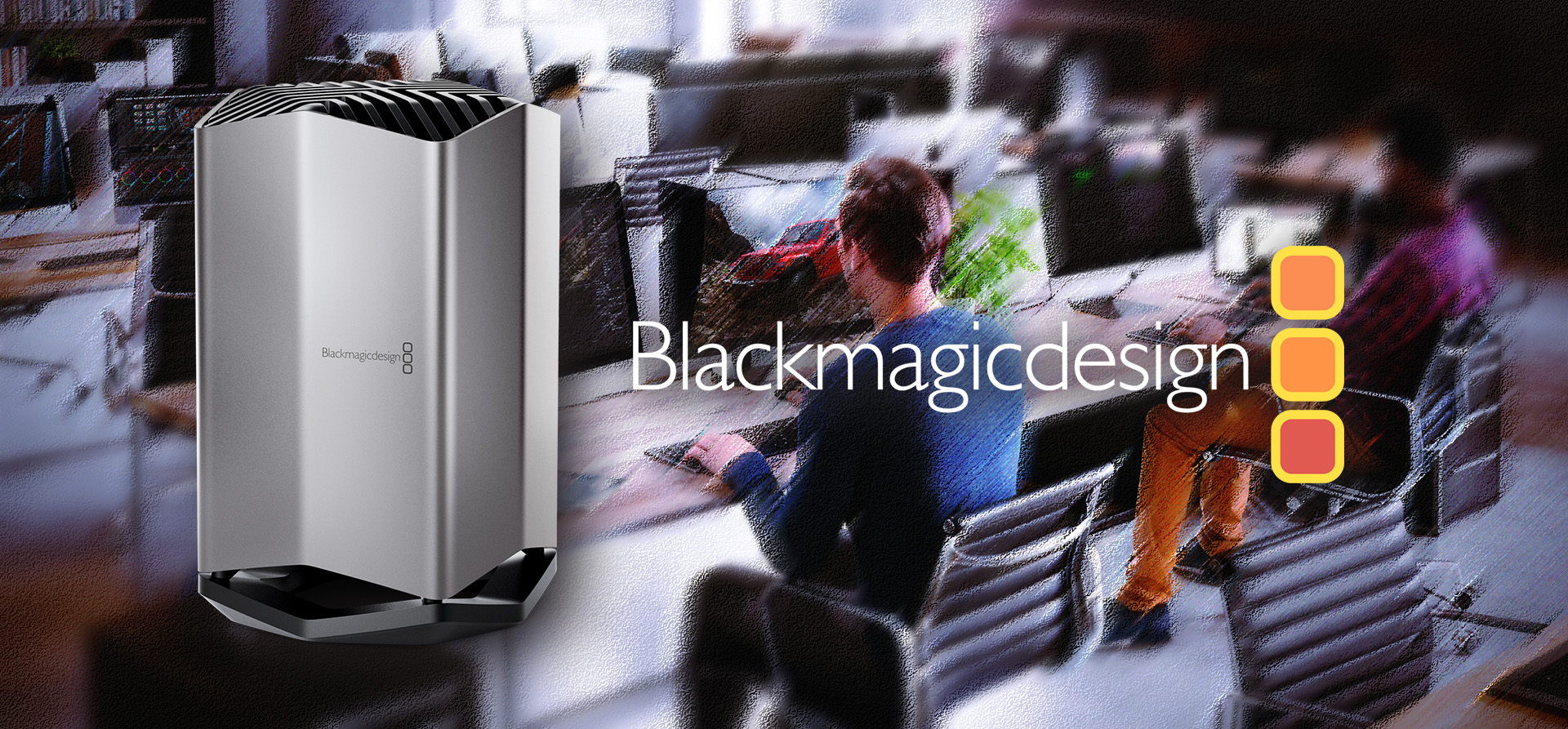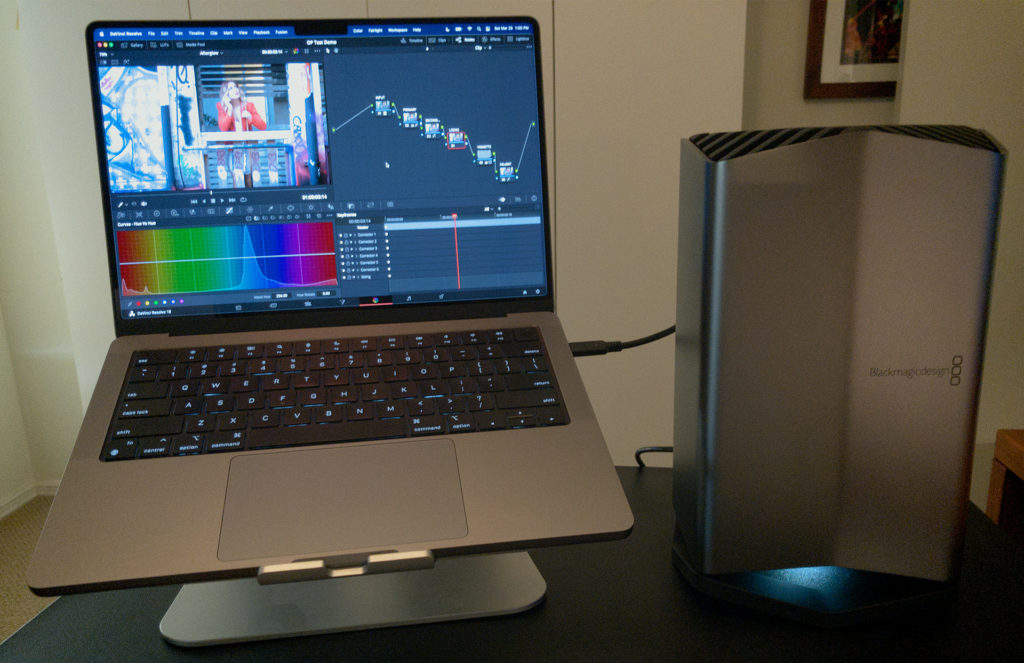
Last year Blackmagic Design announced a new line of network storage products along with Blackmagic Cloud. The storage products include Blackmagic Cloud Store (a high-performance RAID-5 array), Blackmagic Cloud Store Mini 8TB (a RAID-0 storage solution), and Blackmagic Cloud Pod (an appliance to turn any USB-C drive into network storage). I reviewed the Blackmagic Cloud Store Mini in August. Now its big brother, Blackmagic Cloud Store, is finally shipping, along with lower prices.
Good things in small packages
Blackmagic Cloud Store comes in three sizes: 20TB ($7,595 USD), 80TB ($22,995 USD), and 320TB (built to order). Each uses the same canister-style enclosure as the company’s eGPU. It features dual power supplies and fast, quiet M.2 SSD memory cards, which are installed around a central core. You can literally leave it on your desk and hardly hear the fans running. Cloud Store runs Blackmagic OS and applies wear leveling, so each M.2 card won’t see excessive data writes. Every sixth M.2 card is used for RAID-5 parity/data protection. The quoted capacity is a net figure, meaning you actually have the full 20TB, 80TB, or 320TB of useable storage.
In the unlikely case of hardware issues, such an M.2 SSD card going down, you would need to contact Blackmagic Design support. Cloud Store is not designed for end-user repair. However, it would be easy to repair by an authorized service engineer, even though it’s not a rack mount design. Various internal assemblies can be unbolted from the core chassis and replaced.
For editors and colorists working with shared media, there’s a built-in 10G switch with four 10G high-speed (10Gb/s) ethernet ports. Connect an external network switch to one of these if you need high-speed access to the array from more than four computers. Next, there are two USB-C and two standard 1G ethernet ports, which can be used to connect additional users at slower ethernet speeds.
The intended use for the USB ports is to connect external drives for ingest and back-up. An ethernet cable from your internet modem or switch to the 1G ports is needed for Dropbox and Google Drive syncing (more on that in a moment). There is also an HDMI port for a monitor used to display real-time data, such as storage activity, drive health, and connected users. Functions like port aggregation of the 10G switch and the USB-C media I/O have not yet been enabled.
In theory, all eight data ports could be used to connect users, if you forgo syncing and the media I/O function. Although the M.2 SSD array is fast, the network connections will determine the true speed. For example, the 1G and USB-C ports yield write/read speeds of around 200-300MB/s, whereas the 10G ports perform in the 800-1,100 MB/s range.
Setting up a shared network
Download the Blackmagic Cloud Store set-up application to your computer. Run the installer for the set-up app, a user guide PDF, and the standalone Proxy Generator application. Review the network set-up section of the user guide. You can connect a device without using the application, but you’ll need it to set up media sharing over the internet. Bring your own standard 3-prong AC power cord for the unit, too.
I created a small workgroup by connecting the Blackmagic Cloud Store to my 2020 27″ iMac and my 2021 14″ M1 Max MacBook Pro. The iMac has a 10G port and was directly connected. The MacBook Pro was connected using a Sonnet Solo 10G Thunderbolt-to-10G ethernet adapter. If you use a bus-powered adapter like the Sonnet with a laptop, make sure you keep the laptop on AC power. Otherwise, the storage volume will tend to unmount. As with most NAS systems, each time you start the computer, you’ll need to manually mount the storage volume again within the OS.
The Cloud Store device is largely plug-and-play using standard network protocols built into the computer’s operating system. The iMac connected right away, but, I had to change the IP address for the MacBook Pro within its preferences. Other than that minor hiccup, setting up Blackmagic Cloud Store was the easiest installation that I’ve ever done with any NAS system.
If you are using Blackmagic Cloud Store on-premises in a workgroup, then you are set to go. Blackmagic Design intended this to be an easy system to administer. Therefore, you cannot subdivide it into different virtual volumes nor assign different levels of user permissions. The Blackmagic Cloud Store drive is mounted as a single drive volume on your desktop and shared media is accessible on all systems. This product is not solely built for DaVinci Resolve users. Apple Final Cut Pro or Adobe Premiere Pro library/project files also work fine when stored on the Cloud Store volume.
Syncing remote media
Blackmagic Design has factored in remote workflows, which is where Dropbox and Google Drive come in. Connect an ethernet cable for an internet feed to one of the 1G ports on the Blackmagic Cloud Store. There’s a tab in the Cloud Store set-up application for Dropbox or Google Drive. Now assign the Cloud Store volume as the location for your Dropbox or Google Drive folder. You can the opt to share only proxy media or full-res files and proxies. Proxy media files can be generated by DaVinci Resolve itself or using the Proxy Generator application.
Editors with whom you collaborate remotely will have access to the media thanks to Dropbox or Google Drive syncing. The remote editors don’t need Blackmagic Cloud Store units for this to work and can certainly work with other storage solutions. There are a variety of possible workflows, depending on whether it’s an editor sharing files with a colorist or an editor working with assistants on a feature film.
Dropbox and Google Drive syncing allows for an incremental workflow. For example, many productions are filmed over several days. As new media is added to the primary Blackmagic Cloud Store volume, syncing can happen automatically for all remote collaborators. Remember that the Dropbox and Google Drive options are based on your account and not Blackmagic Design. So you may incur charges based on your plan with these companies.
I personally have reservations about leaving your storage directly connected to the internet. As many NAS owners who had systems exposed to the internet can attest, getting hacked and having your media held for ransom is a very real risk. So take precautions – you’ve been warned.
Blackmagic Cloud and DaVinci Resolve
Blackmagic Design has specifically tailored the workflow for DaVinci Resolve, which works with a database (library) containing multiple projects. There are three types of databases: local (stored on your computer), server (stored on a separate networked computer), or cloud, i.e. the Blackmagic Cloud server. Anyone can sign up at the Blackmagic Design website to get their own free Cloud account. If you decide to add a library to Blackmagic Cloud, then the charge is $5 per month, per library. Of course, a single library can contain multiple projects.
In a typical Blackmagic Cloud scenario, the main editor adds a Resolve library to Cloud and creates the active Resolve project there. When its time to share the project with other editors/VFX artists/colorists, turn on multi-user collaboration within Resolve. The library owner sends an invitation to the email address tied to the remote user’s account. The second editor has already received the media via a shipped drive or synced over the internet. That editor logs into their Blackmagic Cloud account to gain access to the library and that project. Open the project, relink the media, and it’s off to the races.
The first person to open a sequence has write access to that sequence. Everyone else has read-only access to the open sequence, but write access to any others that they open. If a change is made to a writeable sequence and saved, the library on Blackmagic Cloud is updated. This is relatively fast, but not as instant as if the database were local. Anyone viewing the sequence in a read-only mode is prompted to refresh the sequence. Both Resolve Studio and Resolve (the free App Store version) worked fine.
Who this is for?
There are three potential use cases for Blackmagic Cloud Store. You could simply use it as a local drive attached to one computer. This wouldn’t be the best solution, because Thunderbolt arrays are faster and cheaper. The second use case is the small workgroup under one roof. For example, this could be a small post house or a team of editors cutting a film. Simply connect four computers to the Blackmagic Cloud Store unit and now everyone can share media and project files.
The final use case embraces a remote workflow. One or more users are connected to a Blackmagic Cloud Store at one location. They can then share media and Resolve projects using the built-in syncing and Blackmagic Cloud. For example, you might be a great editor, but not the best colorist. Using this workflow, you could share your project remotely with an experienced colorist and work together through a sequence interactively. Or it’s a feature film and several editors, each working remotely, is editing a different reel of the same film.
There’s plenty of competition in the market for shared, networked storage solutions. Most require a certain level of IT knowledge to set up and administer. Blackmagic Cloud Store is a deceptively simple, yet powerful, storage device that can fit many operational models. It’s a high-performance drive array that can sit quietly on your desktop without the need for rack space or extra cooling. Couple it with a Blackmagic Cloud account and you have one of the simplest way to collaborate across town or across the country.
Images courtesy of Blackmagic Design

